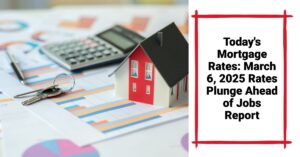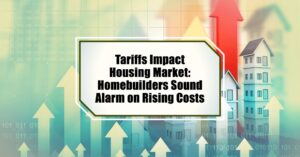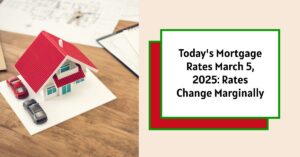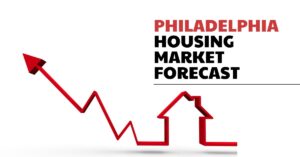Mortgage rates have indeed plunged to their lowest points this year on March 7, 2025, providing a great opportunity for prospective homeowners and those looking to refinance. According to the latest data from Freddie Mac, the national average for a 30-year fixed mortgage is now 6.35%, while the 15-year fixed rate has dropped to 5.66%. This decline can be attributed to various economic factors, including recent changes in tariffs and upcoming reports regarding jobs and inflation, which may influence rates in the near future.
Today's Mortgage Rates March 7, 2025: Rates Drop to Lowest Points
Key Takeaways
- Mortgage Rates Low: Rates are currently lower than they have been this year.
- 30-Year Fixed Mortgage Rate: Currently at 6.35%.
- 15-Year Fixed Mortgage Rate: Reduced to 5.66%.
- Refinance Rates: Also experiencing a downward trend.
- Economic Factors in Play: Changing tariffs and inflation reports could influence future mortgage rates.
Current Mortgage Rates
Based on data from Zillow and other reliable sources, here are the mortgage rates as of March 7, 2025:
| Loan Type | Current Rate (%) |
|---|---|
| 30-Year Fixed | 6.35% |
| 20-Year Fixed | 6.10% |
| 15-Year Fixed | 5.66% |
| 5/1 ARM | 6.11% |
| 7/1 ARM | 6.32% |
| 30-Year VA | 5.85% |
| 15-Year VA | 5.28% |
| 5/1 VA | 5.84% |
Current Mortgage Refinance Rates
The refinance mortgage rates today are:
| Loan Type | Current Rate (%) |
|---|---|
| 30-Year Fixed | 6.38% |
| 20-Year Fixed | 6.11% |
| 15-Year Fixed | 5.66% |
| 5/1 ARM | 6.30% |
| 7/1 ARM | 6.47% |
| 30-Year VA | 5.87% |
| 15-Year VA | 5.56% |
| 5/1 VA | 5.98% |
| 30-Year FHA | 6.04% |
| 15-Year FHA | 5.33% |
This data indicates a favorable situation for anyone considering refinancing to reduce monthly payments or overall interest costs. While rates are low now, individual situations may vary, and it's important for homeowners to analyze their options closely.
How Mortgage Interest Rates Work
Simply put, a mortgage interest rate is the fee lenders charge for borrowing money, expressed as a percentage. There are two primary types of rates:
- Fixed-Rate Mortgages: The interest rate remains the same throughout the life of the loan. This stability offers peace of mind, as borrowings maintain predictable monthly payments. This can be particularly reassuring in uncertain economic climates.
- Adjustable-Rate Mortgages (ARMs): These rates change after a specific period. Initially, they might be lower than fixed rates, which can lead to significant savings for borrowers who plan to move before the rate adjusts. However, borrowers must be cautious, as rates can increase after the initial period, leading to higher payments.
Understanding these options is crucial because the type of mortgage you choose can impact your financial future significantly. Fixed-rate mortgages provide consistent payments and security against inflation, while ARMs might be suitable for buyers who expect to relocate shortly.
Monthly Payments Under Current Rates
Understanding how your monthly payments will look under current mortgage rates is crucial for budgeting. Let’s calculate the monthly payments for different mortgage amounts at 6.35% for 30-year fixed mortgages and 5.66% for 15-year fixed mortgages, as outlined below.
Monthly Payment on a $150,000 Mortgage
- 30-Year Fixed at 6.35%: Approximately $934.05
- 15-Year Fixed at 5.66%: Approximately $1,215.11
Monthly Payment on a $200,000 Mortgage
- 30-Year Fixed at 6.35%: Approximately $1,245.40
- 15-Year Fixed at 5.66%: Approximately $1,620.14
Monthly Payment on a $300,000 Mortgage
- 30-Year Fixed at 6.35%: Approximately $1,856.60
- 15-Year Fixed at 5.66%: Approximately $2,430.21
Monthly Payment on a $400,000 Mortgage
- 30-Year Fixed at 6.35%: Approximately $2,467.80
- 15-Year Fixed at 5.66%: Approximately $3,240.28
Monthly Payment on a $500,000 Mortgage
- 30-Year Fixed at 6.35%: Approximately $3,079.00
- 15-Year Fixed at 5.66%: Approximately $4,050.35
These examples illustrate how various mortgage amounts affect monthly payments under current interest rates. Importantly, these payments do not include property taxes, homeowner's insurance, or mortgage insurance, which could impact your overall monthly costs.
Recommended Read:
Mortgage Rates Trends as of March 6, 2025
Mortgage Rates Drop: Can You Finally Afford a $400,000 Home?
Mortgage Rates Forecast March 2025: Will Rates Finally Drop?
Expect High Mortgage Rates Until 2026: Fannie Mae's 2-Year Forecast
Understanding the Economic Impact on Mortgage Rates
The recent drop in mortgage rates has been largely influenced by economic uncertainties. Here's a closer look at the factors impacting these fluctuations:
- Inflation: Inflation plays a critical role in mortgage rates. When inflation is high, the Federal Reserve might increase interest rates to cool down the economy. Conversely, lower inflation can lead to lower mortgage rates.
- Employment Reports: Strong job growth can lead to economic confidence, pushing rates upward. Conversely, weak employment data can lead to lower rates as the economy shows signs of strain.
- Federal Reserve Actions: The Federal Reserve's monetary policy, including changes to the federal funds rate, has a profound effect on mortgage rates. If the Fed signals a desire to keep rates low to stimulate the economy, it helps to keep mortgage rates down.
- Geopolitical Factors: Events like trade tariffs or international conflicts can create uncertainty in the markets. For example, recent tariffs imposed by the U.S. government may have created panic, leading to lower rates as people shift their investments to safer assets, such as bonds.
As we analyze such trends, it becomes clear that now may be the moment to consider obtaining a mortgage or refinancing an existing one while rates remain low.
The Importance of Monitoring Rates
The fluctuating nature of mortgage rates makes it essential to stay attentive. While current rates provide an enticing opportunity, they can shift due to multiple influences. Keeping up with financial news, economic indicators, and trends helps you make informed decisions. Financial tools and resources, like those offered by Yahoo Finance's home affordability calculator, can also assist in assessing which mortgage options fit best with your financial situation.
How to Choose the Right Mortgage
Choosing the right mortgage involves examining both your current financial situation and future plans:
- Assess Your Finances: Before committing to a mortgage, it's essential to evaluate your budget, savings, income stability, and long-term financial goals. Can you afford the monthly payments? How does that fit into your overall financial health?
- Consider Your Time Frame: If you plan on living in your home for a long time, a fixed-rate mortgage might be best. However, if you plan to sell or move within a few years, an ARM may yield lower initial payments.
- Shop Around: Don't settle for the first offer you get. Shopping for the best rates and terms across different lenders can lead to significant savings—small differences in rates can lead to substantial differences in total cost over time.
- Consider Additional Costs: Besides monthly payments, be aware of closing costs, property taxes, homeowner’s insurance, and potential homeowner association (HOA) fees. Items such as these can add significantly to your monthly obligations.
Ultimately, the decision to mortgage or refinance extensively depends on individual circumstances, varying from person to person.
Summary:
Given the significant drop in mortgage rates today, especially for 30-year and 15-year fixed mortgages, there is a tangible opportunity for prospective homebuyers and those looking to refinance. With robust data backing these trends, it's essential to monitor how broader economic factors may influence mortgage rates going forward.
Work With Norada, Your Trusted Source for
Real Estate Investments
With mortgage rates fluctuating, investing in turnkey real estate
can help you secure consistent returns.
Expand your portfolio confidently, even in a shifting interest rate environment.
Speak with our expert investment counselors (No Obligation):
(800) 611-3060
Recommended Read:
- Mortgage Rate Predictions 2025 from 4 Leading Housing Experts
- Mortgage Rates Forecast for the Next 3 Years: 2025 to 2027
- 30-Year Mortgage Rate Forecast for the Next 5 Years
- 15-Year Mortgage Rate Forecast for the Next 5 Years
- Why Are Mortgage Rates Going Up in 2025: Will Rates Drop?
- Why Are Mortgage Rates So High and Predictions for 2025
- Will Mortgage Rates Ever Be 3% Again in the Future?
- Mortgage Rates Predictions for Next 2 Years
- Mortgage Rate Predictions for Next 5 Years
- Mortgage Rate Predictions: Why 2% and 3% Rates are Out of Reach
- How Lower Mortgage Rates Can Save You Thousands?
- How to Get a Low Mortgage Interest Rate?
- Will Mortgage Rates Ever Be 4% Again?











